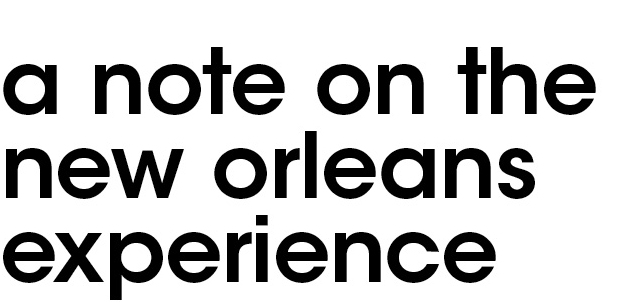
by the Editors
How we see New Orleans, how we have seen it, and how we might see it still.
Photo by Brian Rosa.
As we write this, Hurricane Gustav is bearing down on the banks of the Gulf Coast, and New Orleans has once again been emptied of its residents. We could never have predicted that Gustav's landfall would coincide with the anniversary of Hurricane Katrina and with the Republican National Convention (as well as with the publication of this issue), but we might have expected it. The force of this storm’s symbolism may have surpassed that of its winds, but as ocean temperatures have steadily risen, so has the frequency of Category 4 and 5 storms. The Army Corps of Engineers recently admitted that, even with the repairs made to New Orleans’s levee system, each year there is still a decent chance that one-third of the city will be submerged under six feet of water. This month’s headlines sound like the knell of the so-called hundred-year storm.Even as we endeavor to describe, in the blunt terms of before and after, what Hurricane Katrina has done—as we listen to those who endured it, exhibit the drawings and photographs of artists whose work could not have been made anywhere else or at any other time, and consider the perspectives of those who were drawn to the city by images and reports of human misery and governmental indifference—we cannot help but envision a near-permanent state of evacuation. That, too, is what has drawn people to the city over the past three years: the prospect of witnessing—perhaps preserving, but perhaps merely witnessing—a legendary culture and place whose disappearance somehow seems imminent.
This issue contains the voices of residents, but nonresidents predominate. Most of us have been indirectly affected by Hurricane Katrina. We occupy distant ground, distant perspectives, but have felt compelled to respond nonetheless. This impulse, shared by so many Americans, seems to have been prompted by the desire to restore a part of what once was, but also by the anticipation of a radically altered landscape, which we might behold as a new thing.
In his essay “The Loss of the Creature,” Walker Percy, himself a great chronicler of life in New Orleans, explains why the tourist seeks such a novel experience—an “immediate encounter with being”—and why, failing to achieve it, he “carves his initials in a public place”:
He does so because in his role of consumer of an experience (a “recreational experience” to satisfy a “recreational need”) he knows that he is disinherited…that he is in a very special sort of zone in which his only rights are the rights of a consumer…. He carves his initials as a last desperate measure to escape his ghostly role of consumer. He is saying in effect: I am not a ghost after all; I am a sovereign person. And he establishes title the only way remaining to him, by staking his claim over one square inch of wood or stone.
As tourists ourselves, we are deeply sensitive to the memories of longtime residents—for those who have lived in New Orleans for generations, there is no singular before or after—yet we are no less interested in how Katrina fundamentally altered the outsider’s experience of New Orleans. In the case of a disaster, Percy observes, “a loss of title occurs,” sweeping away expectations and granting us a new sovereignty over our experience of a place. To many, the New Orleans that emerged as the floodwaters receded was a land that had yet to be discovered and described.That has changed with time. But it now seems impossible for someone to visit New Orleans and have, or expect to have, the “recreational experience” on offer before Katrina. The city is not that New Orleans anymore, but something related to its life and its death.
—The Editors